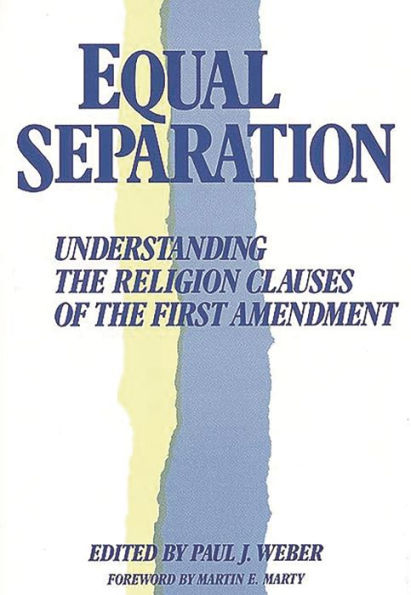Equal Separation: Understanding the Religion Clauses of the First Amendment
Scholars agree that religion-clause jurisprudence is in disarray: The Supreme Court is divided on the issue; religious lobbyists and litigators aggressively pursue their often conflicting goals; and novel pieces of church-state litigation are frequent news items. Editor Paul J. Weber argues that a 25-year-old theory called strict neutrality may provide a foundation on which a more compelling theory of the First Amendment religion clauses can be developed. Although superficially examined in a search for new approaches by many law-review authors, very little serious analysis has been done of strict neutrality/equal separation and little attempt has been made to develop the concept. In Equal Separation, the pros and cons of strict neutrality are argued by six outstanding scholars who represent a challenging array of viewpoints; each critiques the concept by focusing on a different perspective. Despite vigorous disagreement over the conditions required for religious liberty and nonestablishment and the means necessary to achieve them, each author's dedication to the concepts is clearly manifested in this volume.
In the first chapter, Weber outlines a strict neutrality thesis. The next three chapters enlarge upon criticisms that focus on a defense of the free exercise of religion; offer a defense against strict neutrality's assault on the establishment clause; and contrast accommodation—pluralist theory—with strict neutrality. The issue of strict neutrality and the schools is addressed in Chapter 5, and an overview of the Court's development of the concept of separation of church and state is presented in Chapter 6. The editor's concluding chapter explores the criticisms and defends the strict neutrality/equal separation theory. This volume will be of particular interest to constitutional scholars, jurisprudents, and professors and students of law.
1111303296
In the first chapter, Weber outlines a strict neutrality thesis. The next three chapters enlarge upon criticisms that focus on a defense of the free exercise of religion; offer a defense against strict neutrality's assault on the establishment clause; and contrast accommodation—pluralist theory—with strict neutrality. The issue of strict neutrality and the schools is addressed in Chapter 5, and an overview of the Court's development of the concept of separation of church and state is presented in Chapter 6. The editor's concluding chapter explores the criticisms and defends the strict neutrality/equal separation theory. This volume will be of particular interest to constitutional scholars, jurisprudents, and professors and students of law.
Equal Separation: Understanding the Religion Clauses of the First Amendment
Scholars agree that religion-clause jurisprudence is in disarray: The Supreme Court is divided on the issue; religious lobbyists and litigators aggressively pursue their often conflicting goals; and novel pieces of church-state litigation are frequent news items. Editor Paul J. Weber argues that a 25-year-old theory called strict neutrality may provide a foundation on which a more compelling theory of the First Amendment religion clauses can be developed. Although superficially examined in a search for new approaches by many law-review authors, very little serious analysis has been done of strict neutrality/equal separation and little attempt has been made to develop the concept. In Equal Separation, the pros and cons of strict neutrality are argued by six outstanding scholars who represent a challenging array of viewpoints; each critiques the concept by focusing on a different perspective. Despite vigorous disagreement over the conditions required for religious liberty and nonestablishment and the means necessary to achieve them, each author's dedication to the concepts is clearly manifested in this volume.
In the first chapter, Weber outlines a strict neutrality thesis. The next three chapters enlarge upon criticisms that focus on a defense of the free exercise of religion; offer a defense against strict neutrality's assault on the establishment clause; and contrast accommodation—pluralist theory—with strict neutrality. The issue of strict neutrality and the schools is addressed in Chapter 5, and an overview of the Court's development of the concept of separation of church and state is presented in Chapter 6. The editor's concluding chapter explores the criticisms and defends the strict neutrality/equal separation theory. This volume will be of particular interest to constitutional scholars, jurisprudents, and professors and students of law.
In the first chapter, Weber outlines a strict neutrality thesis. The next three chapters enlarge upon criticisms that focus on a defense of the free exercise of religion; offer a defense against strict neutrality's assault on the establishment clause; and contrast accommodation—pluralist theory—with strict neutrality. The issue of strict neutrality and the schools is addressed in Chapter 5, and an overview of the Court's development of the concept of separation of church and state is presented in Chapter 6. The editor's concluding chapter explores the criticisms and defends the strict neutrality/equal separation theory. This volume will be of particular interest to constitutional scholars, jurisprudents, and professors and students of law.
75.0
In Stock
5
1

Equal Separation: Understanding the Religion Clauses of the First Amendment
200
Equal Separation: Understanding the Religion Clauses of the First Amendment
200Hardcover
$75.00
75.0
In Stock

Product Details
| ISBN-13: | 9780313267000 |
|---|---|
| Publisher: | Bloomsbury Academic |
| Publication date: | 05/23/1990 |
| Series: | Contributions in Legal Studies , #58 |
| Pages: | 200 |
| Product dimensions: | 6.14(w) x 9.21(h) x 0.50(d) |
| Lexile: | 1540L (what's this?) |
About the Author
From the B&N Reads Blog
